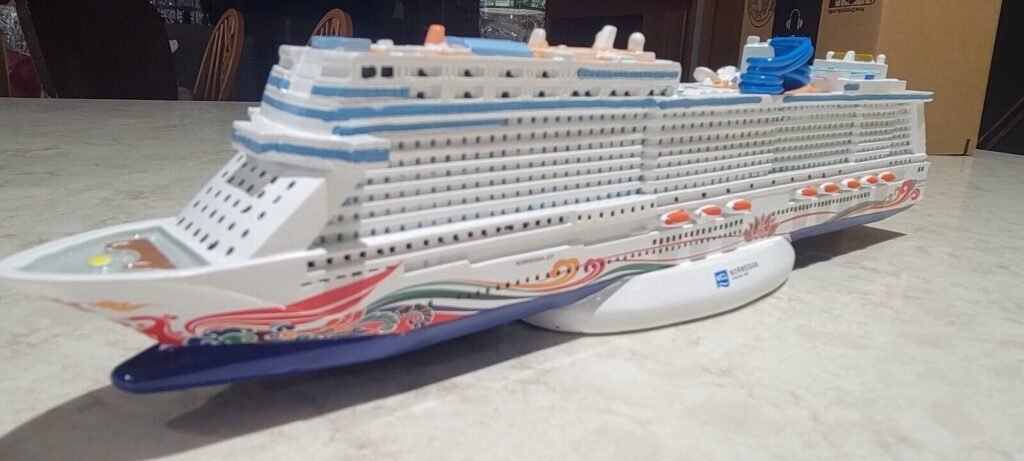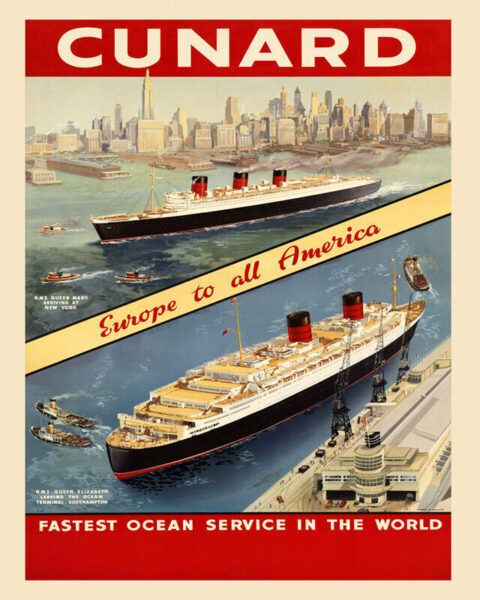#Collecting #Cruise #Ship #Mementos #WorthPoint
An ocean cruise is a vacation choice thousands of people make every year. Modern cruise ships have every amenity imaginable, from fine dining to race cars on deck and Broadway-caliber shows every night. But what about souvenirs? Sure, the gift shops sell T-shirts and other bits, but what about collectibles of the ships themselves? Paintings, ephemera, models, and even furnishings are all examples of what some cruise fans collect.

NOT ALL SHIPS ARE THE SAME
While many might think that a boat is a boat, collectors are a much more specific bunch. First off, they are ships, not boats. Terminology matters, and as any cruise ship crewmember or enthusiast will tell you, they are not boats; they are ships.
Another notable difference is that modern cruise ships differ from the classic ships of decades ago. Ships like the Queen Mary, the Liberte, and the SS United States were ocean liners, and they were very different from modern cruise ships. Today, only one genuine ocean liner is in operation: the Queen Mary 2, which is part of the Cunard Line.
Ocean liners were originally used for transatlantic crossings, with passengers traveling from the East coast of the United States, usually New York City, to European ports like Southampton in the UK or Le Havre in France. The art deco items from these ships, along with postcards, photos, and even paint chips, are hot collectibles for history buffs and fans of nautical items.

MODERN SHIPS
One of the more popular items modern cruise ship fans like to collect are models of the ships they’ve traveled on. Every ship has a gift shop, and a top seller is usually one of the ships’ models. Some are very ornate and detailed, with brass or wood elements; others are less intricate and brightly colored, but true cruise collectors will usually have more than a few. While the models are not rare, as the cruise lines have them mass-produced, they are typically only sold in the gift shop of the ship they represent. When they sell out, it can be months before a new batch arrives on board.
The only way to get one is to travel on the ship or ask a passenger who will be on the ship to bring one back. They sell well on the secondary market, especially on eBay, as passengers who sailed on a ship that was sold out of them will usually try to find them in online auctions. This article features a collector with over seventy cruise ship models, most of which are from cruises he has personally taken.

Pins from cruise ships are also popular with collectors. The Disney Cruise Line arguably leads the way in this as they have regular pin trading events on their ships. Other lines issue pins for particular voyages, like the first time a ship carries passengers or a special voyage. While most collectible pins are from modern-day ships, some represent older ships. This one, from the Lusitania, is a rare example of a commemorative pin that was not your average mass-produced souvenir.
SHIPBOARD ITEMS
Souvenir items like pins, keychains, and other tchotchkes have their fans, but some collectors want items that passengers and crew may have used on board, which often includes ephemera like menus and postcards. Dinnerware and drinkware are also popular with collectors who like a bit of nostalgia. Owning a dinner plate or menu from a cruise ship that no longer exists is a coup for some collectors since these items can be hard to find.

Fixtures and fittings from ships are also popular since once a cruise ship is scrapped, nothing remains of it. The Admiral Cruise Line, part of the Pacific Steamship Company, took passengers from the West Coast to ports in Asia. This door knob set, complete with a key, came off one of their ships.
SEA TRAGEDIES
While many collectors like to accumulate happy souvenirs, artwork, and other mementos of ships, some who follow maritime history will want items from ships that suffered tragedies at sea. Most memorable is the RMS Titanic, which sank after striking an iceberg in the early morning of April 15, 1912. While many would think it morbid to collect items from the doomed ship, there have been auctions like this one that included a watch owned by John Jacob Astor, IV, and the violin played by the ship’s bandleader Wallace H. Hartley.
Items from other sea tragedies, like the torpedo attack on the RMS Lusitania and the wreck of the Andrea Doria after a collision with the Stockholm, have also shown up in auctions. While there is some controversy over the ethics of diving into and retrieving items from shipwrecks where passengers died, the artifacts are of significant historical value, and many who purchase them do so to preserve the history of these great ships.
FINDING VINTAGE SHIP ITEMS
While cruising the ocean on a floating paradise lures thousands of vacationers, collecting vintage and modern items from ships is also a popular pastime. Online auction sites usually have many items in the souvenir categories from ships still sailing. Still, collectors might have to look harder for vintage items from vessels that have been decommissioned or scrapped. Antique shops and estate sales will sometimes feature magazine articles or other ephemera. Family members of passengers who sailed aboard some of the more famous ships and liners often don’t realize they might have letters or other memorabilia, so looking through collections of postcards or newspapers might yield an unforgettable, if not unsinkable, find.
Check out the WorthPoint Price Guide for more information on cruise ships, ocean liners, and other vintage nautical items.
Brenda Kelley Kim lives in the Boston area. She is the author of Sink or Swim: Tales From the Deep End of Everywhere and writes a weekly syndicated column for The Marblehead Weekly News/Essex Media Group. When not writing or walking her snorty pug, Penny, she enjoys yard sales, flea markets, and badminton.
WorthPoint—Discover. Value. Preserve.




